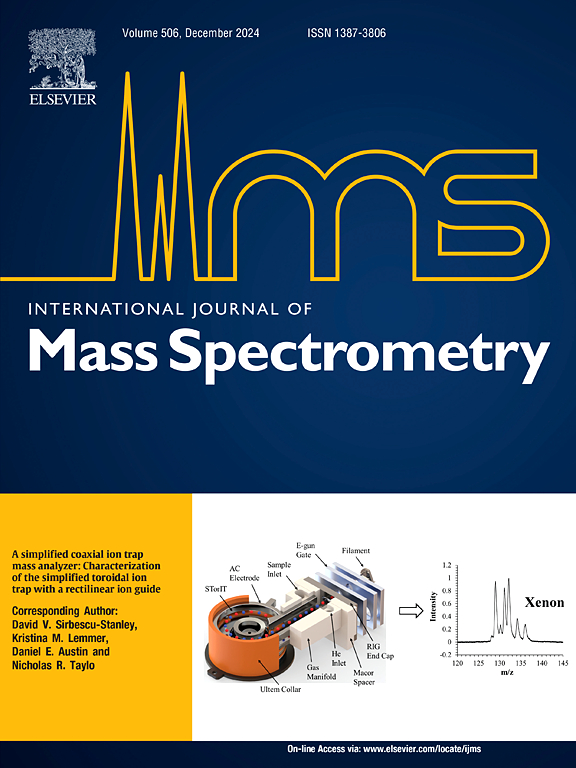Activation of CH4 and C2H6 by Al2O2+ from 300 to 600 K
IF 1.7
3区 化学
Q3 PHYSICS, ATOMIC, MOLECULAR & CHEMICAL
引用次数: 0
Abstract
The kinetics of Al2O2+ + CH4 and Al2O2+ + C2H6 are measured from 300 to 600 K at pressures near ∼0.35 Torr in a Selected-Ion Flow Tube apparatus. The reaction with CH4 proceeds by hydrogen abstraction to yield an open chain AlOAlOH+ +CH3. The rate constant is nearly temperature-independent at 7 ± 2 × 10−11 cm3 s−1. This competes with association, which decreases sharply with temperature (k = 3.3 ± 0.8 × 10−10 (T/300 K)−3.1±0.2 cm3 s−1). The reaction with C2H6 primarily yields Al2O2H2+ + C2H4. The rate constant for this channel k300K = 4 ± 1 × 10−10 cm3 s−1 with a very slight negative temperature dependence. A second channel producing C2H5 + Al2O2H+ rises steeply with temperature (k = 10 ± 2 × 10−10 e−0.12 eV/kT cm3 s−1), and finally association decreases steeply with temperature (k = 6 ± 1.5 × 10−10 (T/300 K)−3.2±0.2 cm3 s−1). The reaction with methane is well-described using statistical theory based on reaction coordinates calculated using density functional theory. The total rate constant for the ethane reaction is also well-described using statistical theory, but the product branching is not, suggesting post-transition state non-statistical dynamics. One possibility is that the ethane reaction unexpectedly produces a higher energy C2v isomer of Al2O2H+. The results support the prior interpretation that Al2O2+ activates hydrocarbons via a proton-coupled electron transfer (PCET) mechanism and not a hydrogen-atom transfer (HAT) mechanism.

300 ~ 600 K Al2O2+对CH4和C2H6的活化
在选择离子流管装置中测量了Al2O2+ + CH4和Al2O2+ + C2H6在300至600 K的压力下接近0.35 Torr的动力学。与CH4的反应通过抽氢生成开链AlOAlOH+ +CH3。速率常数在7±2 × 10−11 cm3 s−1时几乎与温度无关。这与缔合作用形成竞争,缔合作用随着温度的升高而急剧降低(k = 3.3±0.8 × 10−10 (T/300 k)−3.1±0.2 cm3 s−1)。与C2H6反应主要生成Al2O2H2+ + C2H4。该通道的速率常数k300K = 4±1 × 10−10 cm3 s−1,与温度呈极轻微的负相关。生成C2H5 + Al2O2H+的第二通道随温度急剧上升(k = 10±2 × 10−10 e−0.12 eV/kT cm3 s−1),最后随温度急剧下降(k = 6±1.5 × 10−10 (T/300 k)−3.2±0.2 cm3 s−1)。利用基于密度泛函理论计算的反应坐标的统计理论,很好地描述了与甲烷的反应。乙烷反应的总速率常数也可以用统计理论很好地描述,但产物分支没有,这表明过渡态后的非统计动力学。一种可能是乙烷反应意外地产生了能量更高的Al2O2H+的C2v异构体。结果支持了先前的解释,即Al2O2+通过质子耦合电子转移(PCET)机制而不是氢原子转移(HAT)机制激活碳氢化合物。
本文章由计算机程序翻译,如有差异,请以英文原文为准。
求助全文
约1分钟内获得全文
求助全文
来源期刊
CiteScore
3.60
自引率
5.60%
发文量
145
审稿时长
71 days
期刊介绍:
The journal invites papers that advance the field of mass spectrometry by exploring fundamental aspects of ion processes using both the experimental and theoretical approaches, developing new instrumentation and experimental strategies for chemical analysis using mass spectrometry, developing new computational strategies for data interpretation and integration, reporting new applications of mass spectrometry and hyphenated techniques in biology, chemistry, geology, and physics.
Papers, in which standard mass spectrometry techniques are used for analysis will not be considered.
IJMS publishes full-length articles, short communications, reviews, and feature articles including young scientist features.

 求助内容:
求助内容: 应助结果提醒方式:
应助结果提醒方式:


